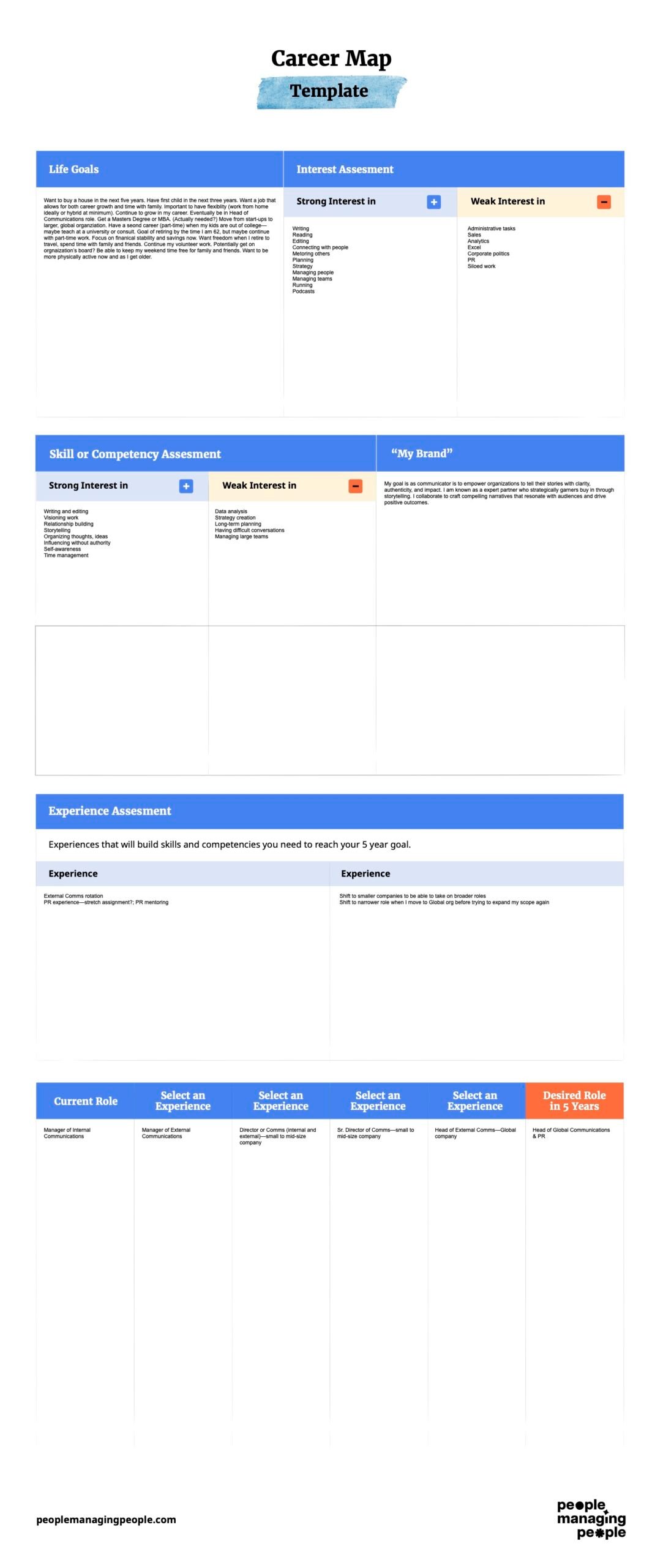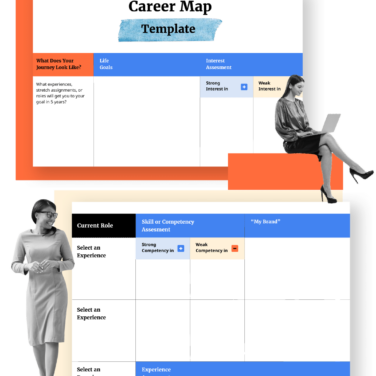While it’s great when companies can provide specific career pathways for people to follow, most people’s careers don't progress in a strictly linear fashion.
This is where a career map comes in handy to help individuals assess potential options and chart their course.
Here I’ll take you through what a career map is, the benefits, and how to run a career mapping exercise. There are also handy examples and a template.
What Is A Career Map?
A career map is a planning tool that helps individuals assess their career options and identify the steps they can take to progress. It’s a framework to assess their current interest and skills, identify potential next roles, and plan next steps—specifically the skills and experiences needed to get there.
The six main sections of a career map are:
Life goals
More than just work goals, it’s important to look at your life goals. We need different things from our careers at different stages in our lives. For example, when you are new to the workforce and trying to establish a reputation vs. when you are more tenured and focused on starting a family.
It’s helpful to consider all of your goals. Consider what you want to accomplish concerning your work, family, home, community, personal growth and learning, hobbies, etc.
You can include things like jobs including scope and responsibility level, where you want to live, when you want to retire, the amount of time you spend with family and friends, hobbies you want to take up or skills you want to develop, how you want to shift the way you work (ex: working inside a company or shifting to consulting), and work and personal travel.
Interest assessment
Describe the work activities in which you have a strong interest vs. the ones in which you have a weak interest. Include functional tasks (specific to the kind of work you do), more general technical tasks (ex: managing a project, building a budget, designing a strategy), and leadership activities (ex: leading a team, coaching, performance management).
These are interests regardless of your current skill set. For example, you may have a weak interest in sales even though you have a high skill set in sales.
Skills/competency assessment
Describe the skills and competencies that are currently a strength and those that are currently a weakness. This is your current competency level regardless of interest. For example, you may have low competency in developing strategies but a high interest in it.
Your brand
Thinking about your work history, how have you shown up over time? What would people say you are known for?
This is an expression of what you do (that value that you add) and the way that you do (what differentiates you from others). This makes up your brand. Also, consider what you want your brand to be in the future.
Future career journey
Based on your life goals, interests, skills/competencies, and personal brand (current and future), what could your future career journey look like? Think about the kinds of roles you want to have in the next five years that will help you get to your ultimate goal.
Fill in the role, function/business unit, and company/type of company as appropriate. Keep in mind that these moves can be promotions, lateral moves, steps back, or diagonal shifts to align with your ultimate goals and time of life.
Experience plan
Think through experiences (also called heat experiences), training/education, stretch assignments, or shifts of role/company/industry that will help you to along your five-year journey.
These can be big or small experiences that help you to develop the skills and competencies you need to reach your goals.
Include things like scope expansion (temporary or permanent); job shadows; certifications, external programs (ex: mini-MBA, training course to develop a new competency); informal leadership roles (ex: new hire buddy); exposure (ex: sitting in on board meetings or introductions to more senior leaders); mentorship or sponsorship opportunities.
Benefits Of Career Mapping
Career mapping is beneficial for both employees and organizations.
Benefits for employees:
- Autonomy: Rather than relying on the company to provide career path clarity, a career map is driven by the individual employee. It allows them to lead and choose their path and gives them a way of communicating their goals and aspirations with their leaders.
- Clarity of direction: Using the career map, employees think through and plot out their desired destination and the concrete next steps that will help them get there.
- Development and growth: Learning and skill development is the engine that propels the employee forward on their career path. Identifying the specific skills, experiences, and support needed allows the employee to take ownership of their development.
- Motivation and engagement: Creating a structured but flexible path provides milestones that the employee can strive for, fostering a sense of purpose and accomplishment as they take on experiences that propel them forward.
- Accountability: Outlining specific steps helps employees hold themselves accountable for consistently working toward their career goals.
- Communication: The career map supports clear communication. An employee can share their career map with their direct leader, HR or learning professional, mentors, and sponsors, ensuring that people understand and can support the person’s aspirations.
Benefits for organizations:
- Shared responsibility: By providing a career map resource and putting the employee in the driver’s seat, it takes the pressure off of organizations to define career paths that resonate with all employees.
- Talent pipeline: By ensuring that all employees have and use career maps, the organization is not just supporting but creating the expectation that people continually work on their career growth. This helps to create a pipeline of capable talent through every level of the organization.
- Talent planning: As employees create their career maps, leaders and HR get a much clearer understanding of people’s skills and aspirations. Organizations can use that information to proactively create succession plans for future roles.
- Employee engagement and retention: Employees are likely to have higher engagement when they feel that their company cares about their career growth and they’re more likely to stay and grow their careers internally.
- Readiness and agility: When employees have a clear understanding of their strengths and opportunities and are continually working to build their capabilities, the organization becomes more resilient. The company can adapt more quickly to changing market demands, industry trends, and workforce needs.
Career mapping helps foster a culture of continuous learning, growth, and development. It benefits everyone when individual aspirations and company goals are considered concurrently, and career mapping is an effective tool for creating that alignment.
How To Run A Career Mapping Exercise
You can fill out a career map on your own, but I find it’s much more beneficial to have someone “interview” you and capture your responses.
Step one
Choose someone you trust—e.g. a leader, peer, or HR/learning partner—to facilitate an interview with you using the career map.
It doesn’t have to be your boss. Actually, it can be helpful to have a more neutral party for this part of the activity. Set aside ample time for a thorough conversation–at least 90 minutes.
Step two
The facilitator goes through the first four sections–Life Goals, Interest Assessment, Skills/Competency Assessment, Your Brand—section by section, asking for your input on each.
It’s important to ask probing questions—even something as simple as “Is there anything else?” or “What other things can you think of?”
Ask about specific skills that the person doesn’t mention. For example, “What about your communication skills? Ability to influence? Leading leaders of others? Cross-functional collaboration?” The facilitator needs to have enough knowledge and experience about your business unit and the company to ask good questions.
The facilitator captures all responses on the career map.
Step three
Take a step back and look at what themes emerge. For example:
- Is there something in your life goals around travel or living in other locations that can inform potential parts of your future career journey? (Ex: taking on a regional role that requires travel or relocating for an expat assignment)
- Where do your skills and interests line up? (Ex: a lot of experience in design and high interest in creating and aesthetics)
- Where do your skills and interests not line up? (Ex: high interest in leading people but no experience leading people.)
Something important to note here: If there is a high interest in something but a low skill level, it’s important to designate whether that skill is both teachable and relevant.
For example, if there is a high interest in singing (a talent) but there is low talent and no business need, that can be a hobby.
If there is a high interest in project management (a skill), low skill, but high business needs, that is a development opportunity.
Step four
Use the information from your reflection to talk through your potential career journey. Start with where you want to be in the next five years (or 10, or whatever time frame is most relevant) and work backward from there. Talk through the kinds of roles that you will need to be in to progressively get to your end goal.
Keep in mind that those roles may not all be promotions. If you want to pivot your career, you may need to take a step back to a more junior role to get the functional experience that you need.
If you aspire to a General Manager role, you may need to make one (or more) lateral moves to get more breadth of experience. If you have highly transferable skills, you may need to move diagonally (to a more senior position but in a different function).
Step five
Brainstorm the experiences that can help you to build the skills that you need to progress. Consider:
- Stretch assignments
- Job shadowing
- Job swaps
- Internal training programs
- External training programs
- Self-study
- Mentorship
Capture all of those responses in the Experience Plan section.
Step six
Once the map is completed, the facilitator gives it back (preferably in electronic form) to the employee.
It’s up to them to share it with their leader—either the complete plan or just the information gleaned from it—in a career conversation.
The goal of that conversation is to identify the personal learning plan for the employee, including the timeframe, to help them be ready for their next role.
Career Map Template
Career Map Example

Career Mapping Is A Win-Win
A career mapping exercise is a win-win for both workers and organizations.
It’s a simple exercise that gives employees autonomy to chart their career paths and provides a way to share their aspirations with their leader and others who can help them achieve their career goals.
Organizations benefit from having more focused and engaged employees who feel that the company is invested in their growth and development, making them much more likely to stick around for career progression.
Career paths are rarely linear nowadays, and modern organizations can benefit from adopting a career lattice approach that fosters internal mobility and broader skill development.
Here are some other ways you can help employees with their career development.
Join The People Managing People Community
For further career advice, join our supportive community of HR and people leaders sharing knowledge and expertise to help you grow in your career and make greater impact in your org.


